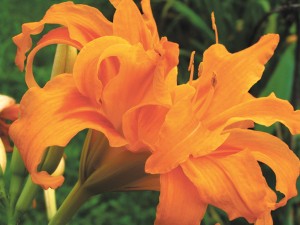Although disliked by some but loved by most, the daylily (Hemerocallis) is often called “the perfect perennial” due to their being available in a rainbow of colors and a variety of shapes and sizes, ability to survive with little care in a wide range of climates, and suitability for all types of landscapes.
Daylilies are drought tolerant when necessary, have relatively few pests and disease problems, are adaptable to various soil and light conditions, and possess — depending upon the cultivar — the ability to bloom from spring to late autumn. They are, along with irises, one of my favorite flowers.
I am fascinated by their many color patterns which include not only “self,” “blend,” “polychrome,” “bitones,” “bicolor,” and “eyed or banded” (where the flower has a zone of a different color or a shade of a darker color located between the throat and the tips of the flower segments) but also “picoted,” “tipped,” “dusted,” and “midrib.”
Then too, I admire the “crispness” or sharp, clean-cut shape of their flowers and, although I do not relish the double flower forms such as “Wayne Johnson” or “Night Embers”, I have recently become attached to the currently popular “spider” types such as “Red Ribbons” with its huge eight inch red and yellow flowers and long, thin petals and “Selma Longlegs” sporting nine inch blooms of light tangerine brushed with cinnamon.
Being the Steward of the Benton House Historic Garden’s collection of 1712-1893 species and cultivars of daylilies, I cannot conclude this article without calling your attention to the fact that daylilies are native to Asia and have been featured in paintings and folk legends going back to Confucius (551-449 BC) when they were grown for food and medicinal uses. The Chinese name for species, Hemerocallis fulva, the commonly seen carrot orange, red eyed and yellow throated roadside, ditch or outhouse daylily, means “forgotten bush,” an allusion to its tranquilizing and hallucinatory properties when boiled and given to those in mourning.
Ed Myers (EMyers3670@aol.com) is a past president of the Irvington Garden Club and the immediate past president of the Garfield Park Master Gardener Association. He is also the steward of both the Benton House Historic and Kile Oak Habitat Gardens. Having grown up in the country, his gardening experience spans over 65 years.



